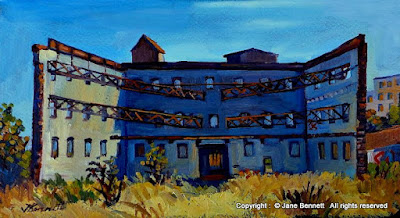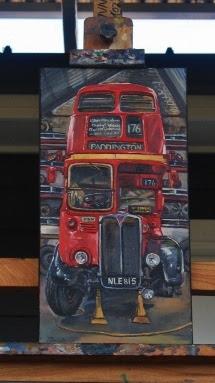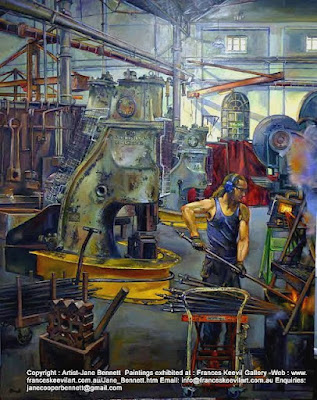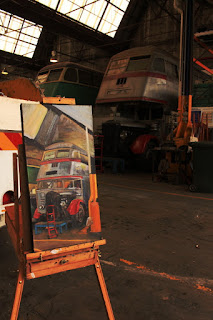The main building was a 4 storey brick flour mill in the utilitarian Federation Free Classical architectural style, with rectangular window openings and a corrugated iron roof behind a plain parapet.
The north facade had a large triangular pediment bearing the business name "Edwin Davey and Sons". On the western side, an extension built out to the cliff line. There was a rail siding from the old Metropolitan Goods Line on the northern side, below the escarpment with some remaining wheat elevation gear and corrugated iron clad extensions at the back of the mill.
By the time of these paintings from the early 2000s, the interior had long been gutted of any machinery and there are obvious horizontal bands of bracing girdling the exterior facade and keeping its last few bricks from falling onto the cars below.

P263A 'Edwin Davey Flour Mill'
2012 oil on board 26 x 38cm
Available
Until the 1860s the Ultimo end of the Pyrmont peninsula was still an undeveloped grazing property owned by Surgeon John Harris and his heirs.
In 1895, 10 lots of Block 42 of the Harris Estate was bought by Freeman and Sons, producers of a large range of household goods, who built a flour mill on the site.
In 1900 Edwin Davey, who already owned mills in South Australia, bought the Ultimo Roller Mills, to produce flour for export, as freight costs from Sydney were better than in Adelaide.

P100 Demolition of the Fielder Gillespie Flour Mills 2
1992 oil on paper 75 x 100cm
Available
The Ultimo Mill went into production in 1901 under the name Chanticleer Flour and operated until 1992, when it became part of Weston Milling Ltd. As the Ultimo mill was small and old fashioned, it was closed, gutted and sold for development.
By coincidence, about the same time, over the opposite side of Pyrmont Peninsula, Fielder Gillespie Flour Mills, next to the Pyrmont Power Station, was also being demolished. After a few weeks the Fielder Gillespie site was completely cleared and remained empty space until eventual redevelopment as a Woolworths and various other shops and offices. By contrast, the ghostly skeleton of the Edwin Davey and Sons building haunted the western edge of Pyrmont for a generation.

P263 'Edwin Davey Flour Mill'
2012 oil on paper 13 x 23cm
Available
By 2001 the building had been reduced to a wafer thin shell of bricks propped up in front of a weedy wasteland.
My painting above shows the interior of the facade, criss-crossed with bracing and scribbled over with cryptic graffiti.






















